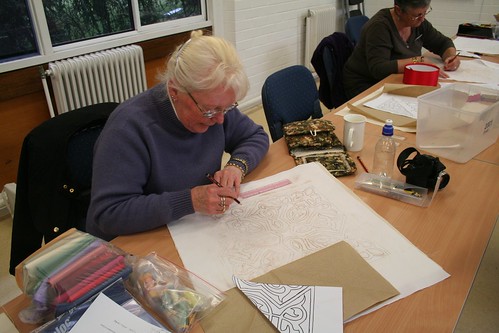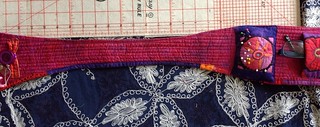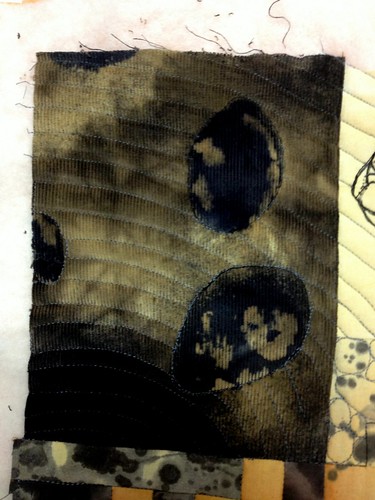After the Last Sky
 Monday, June 18, 2018 at 08:14AM
Monday, June 18, 2018 at 08:14AM Quilt by Jenny Bowker, from a photograph by Mosa’ab Elshamy
 Photographer Andrew Sikorski
Photographer Andrew Sikorski
 Photographer Andrew Sikorski
Photographer Andrew Sikorski
I was lying in bed, as it was night in Canberra when the shooting started in Rabaa el-Adaweya Square in Cairo. We were reading Twitter which had come to life as people tweeted from the squares. One tweet has burned into my brain – “Write your phone numbers on your arms as we can’t identify bodies.”
Shawkan Zeid and Mosa’ab Elshamy were two young photojournalists in Rabaa Square that day. Shawkan never came home – he was gaoled for being there and is still in gaol. Mosa’ab was then a freelance photographer. As people died around him he realised that his camera might be a target and so he went from the Square to the mosques where bodies were being taken. He took hundreds of photographs. His record, on his website, is spectacular but heartbreaking.
It was on his site that I saw the image I have worked with to make this quilt.
The Lead Up
Bob, my husband, was the Australian Ambassador in Egypt from 2005 to 2008. We had left Egypt before Mubarak fell. We watched as crowds gathered in Tahrir Square in 2011 with a degree of envy. It was a fascinating time to see change in a country I loved. People talked excitedly about the Arab Spring and its potential to capture the energy and talents of the younger generation of Egyptians.
I was leading a tour to Syria and Egypt in a few weeks so the unrest was worrying. Ten days before we were due to leave I decided to go to Syria and Jordan instead. The decision was right as many tourists in Egypt had problems getting out, and amid the turmoil there was a wave of attacks on women.
Time moved on. I saw other changes as Egypt elected a new President, Mohamed Morsi, the candidate of the Muslim Brotherhood. Mubarak was gaoled.
Then it all started again. The Brotherhood proved to be a failure in government. Morsi was unable to ‘be a president for all Egyptians’ as promised in the Brotherhood’s election speeches. There were mass demonstrations in opposition to the government, and counter-demonstrations by its supporters.
In July, crowds gathered, carefully encouraged by the Army. Morsi, who had rejected calls to hold fresh elections, was deposed and gaoled. Abdel Fatah el-Sisi, who had been appointed Minister of Defence and head of the Egyptian Armed Forces by Morsi, became President.
Morsi supporters insisted that he had been wrongfully dismissed. They occupied two locations in Cairo, refusing to disperse. On 14 August 2013, military and police moved into Rabaa el-Adaweya Square and Nahda Square and opened fire on the demonstrators. 638 were killed, and 2,104 injured – according to the Egyptian Ministry of Health. The numbers are probably much higher: other estimates of the death toll are between 817 and 1,583. It is accepted that over 3,000 were also injured.
The Scaffolding and Process
When I saw the image of the lone protester against the smoke and fire I contacted Mosa’ab about the image. I asked if I could use it to make a quilt. We discussed the idea and on a trip to Cairo I met Mosa’ab – he seemed SO young – and paid for the rights to make the quilt. He was now working as a photojournalist for Associated Press.
We exchanged contracts and set boundaries. I started thinking about how to make it.

I intended to remove the logo from the Demonstrator’s t-shirt as it is an identifier. With a journalist in prison the demonstrator would also end in prison if his identity was known. Otherwise, I decided to use the image as it was, possibly adding a bit more height. I wanted to use an Egyptian element as piecing. I have always liked adding some piecing to quilts. I enjoy the process and it is a nod to the origins of the medium. There are rugs and saddlebags made in Egypt with the unit I think of as a half-square triangle unit set on point. I love the look of it and it is used right across the Arab world in simple weavings so I decided to pixelate the smoke with these triangles.
I have a private rule for myself that I am a scrap quilter and decided to use only my stash to make this.
I traced the image from an A4 print of the photograph, using and even bigger enlargement to get the hands and face as accurate to the photograph as possible.
I projected those drawings onto tracing paper on my design wall. It took multiple A1 sheets as I wanted the Demonstrator to be larger than life size.
I made the triangles for the smoke and flames first, joined them and put them up on the design wall.
I made the blue tarpaulin next. I had almost decided to eliminate this – but the tarps were used as shelter by the demonstrators as they camped in the square after Morsi’s ouster, and I liked the burst of colour, so it went in.
Then I built up his body in raw edged applique, making sections, then stitching each fabric piece down with monofilament in a fine narrow zigzag. I made his face last as I was nervous about it. I wanted every trace of that anguish. All were made on separate background fabric pieces.
I had to make long strips of the triangles to be sure that I was producing an accurate rectangle and joined them in a lattice to hold the background in shape while I tacked down the figure and face. Then I machined them into place.
The top was then sandwiched and quilted.
The Justification
I am always aware that using another person’s image and reproducing it accurately will incur criticism in the quilting world, especially with an art quilt – in in my mind this is very much an art quilt. It evokes emotion, it tells a story, it has a message and it is visually arresting.
I have wanted to make a quilt about Raba’a for a long time. Finding Mosa’ab’s incredible image was one of those illuminating moments when I realised that everything I wanted to say was in that image – but that very few outside the audience at the time would see the photograph and that very few would go to Mosa’ab Elshamy’s page to search for it.
I know that I could be a conduit to put a brilliant image – a man in extremis, backed by smoke and flames – into audiences that would not see them otherwise. The people dying around him are not visible, but they are implied.
I wanted the rawness of this image in the soft medium of a quilt. I have always liked the fact that people see quilts as a loving warm wrap, as comfort and home and thoughts of grandmothers. I wanted the image to unsettle, to start conversations and to make people think.
I checked that I was not endangering this demonstrator or Mosa’ab with this quilt.
I have always felt that photojournalists put themselves at risk of losing their lives when they document violence, demonstrations, and war. In countries like Egypt they can also lose their freedom as many are now in gaol. There is a basic truth in a photograph that is hard to reproduce in a story. I wanted the quilt to be a salute to the bravery and honesty of photojournalists and truth in journalism.
I had considered other ways to work with this theme but felt that nothing I could imagine would have the ‘punch to the gut’ of this image.
The triangulations of the background evoke the gentle art of weaving in wool and very old traditions of the Middle East. I intended at least one triangle for each person killed – and I have more than that. They also take the image from a photograph to being a quilt, and a quilt that has the ‘how long did that take?” element.
I knew that the image could be read as a symbol of the upheaval and changes over much of the Middle East in the last ten years – Tunisia, Syria, Libya, and Palestine as well as Egypt.
I used bright florals in the fire – to jolt viewers back into recognising something that they might have in their stash, and to remind myself that I was making a patchwork quilt. I also like the juxtaposition of the use of flowers as a memorial with the massacre.
I have been in touch with Mosa’ab throughout the process – and it was a very long process. I was working and travelling and teaching as this was being made so there were long breaks. I have sent him regular updates and he has been enthusiastic and encouraging throughout.
This demonstrator lived through the day, but many hundreds of others did not.
A friend in Ramallah, Tania Nasser, was Mahmoud Darwish’s translator. I asked for and was given permission to use his words as a title long ago, before he died.
The Earth is Closing on Us
The Earth is closing on us
pushing us through the last passage
and we tear off our limbs to pass through.
The Earth is squeezing us.
I wish we were its wheat
so we could die and live again.
I wish the Earth was our mother
so she'd be kind to us.
I wish we were pictures on the rocks
for our dreams to carry as mirrors.
We saw the faces of those who will throw
our children out of the window of this last space.
Our star will hang up mirrors.
Where should we go after the last frontiers?
Where should the birds fly after the last sky?
Where should the plants sleep after the last breath of air?
We will write our names with scarlet steam.
We will cut off the hand of the song to be finished by our flesh.
We will die here, here in the last passage.
Here and here our blood will plant its olive tree.





















































